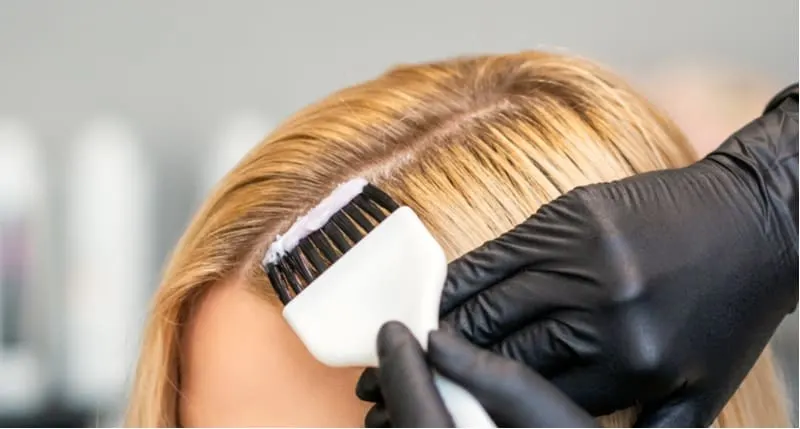What Are Hot Roots?
‘Hot roots‘ is a general term to describe hair in the scalp area that’s lighter than the full length of the hair to the ends. You don’t have to be a trained hair professional to learn how to avoid hot roots when coloring hair, but it’s important to understand why they occur.

With a couple of exceptions (natural redheads and people whose hair is turning gray), most hair is naturally darker when it grows out from the scalp. As it continues to grow out and get longer, hair is not only aging (compared to new hair growing in), but it’s also exposed to environmental elements and natural sunlight. As a result, hair tends to get lighter toward the ends.
Why Do Hot Roots Happen?
There’s no shortage of explanations on how to avoid hot roots, and, likewise, there are plenty of ideas about why they happen in the first place. Here are the two most popular theories:
Theory #1: Body Heat
The human body emits heat; its normal temperature is 98.6 degrees Fahrenheit or 37 degrees Celsius. The scalp also generates body heat, and therefore, the hair growing out from it is “hotter” than the hair located throughout the length of the strands to the ends, which are further away.
Regardless of its source, heat accelerates the speed of the coloring process. When you apply dye or bleach to your hair, the scalp heat combined with the heat generated by the chemical reaction can make the hair that’s closest to your scalp lighter than the rest of your hair. Think of it like throwing kerosene on a barbecue grill.
Theory #2: Keratinization
Congratulations! You can finally say that something you learned in high school biology applies to real life. Remember when you and your lab partner looked at a strand of hair under a microscope? It was probably then that you learned for the first time that hair and fingernails are made up of dead cells. The process of accumulating these dead cells (keratin) that eventually form into hair strands is called “keratinization.”
When you’re dealing with hot roots, it’s helpful to understand keratinization. When new hair grows from the scalp, it takes about a month to fully “harden” once it emerges from the hair follicle. Most people’s hair grows about ½ – 1 inch per month (this figure can vary based on individual hair growth rates). Hot roots appear at that point of new hair growth.
Newer hair is softer and doesn’t have as much hardened keratin as older hair, so dyes and bleach can penetrate more quickly into the hair shaft. When coloring agents are left on new hair for the same amount of time as old hair, they’ll inevitably turn out lighter. Hot roots!
‘I Dyed My Hair and Roots Are Lighter’ – Here’s A Quick Fix
How to Avoid Hot Roots
Most salon professionals believe the best way to avoid hot roots is to minimize errors in the timing and formulation of hair color applications.
When people dye their hair at home, they tend to buy one box of color and apply it to the entire head of hair, from the roots to the ends. The problem is, hair that’s growing out from the scalp is virgin, and therefore, it absorbs the dye faster than the older hair. That’s why the hair at the root level can often be lighter or brassier.
To combat this problem when you apply a color treatment, always dye the full length of your hair first, and save the ½ – 1-inch new growth area until the end. This technique gives the older hair more time to “catch up” to the newer hair that’s absorbing the coloring agent more quickly.
Another way to avoid hot roots is to use two different color formulations on your hair. If you choose to go this route, select a slightly darker shade for the regrowth hair near the roots.
Bleaching Hot Roots

Always apply bleach to the lengths of your hair first, just as you do when using a permanent dye. Hair lengths are older and cooler than root hair that’s located closer to the scalp, so they take more time to lighten.
If you end up with hot roots after bleaching, you’ll need to even them out to match the primary hair color, but remember: permanent hair dye can’t be used to lighten hair that’s already been bleached or previously dyed with permanent dye.
You can re-bleach your hair, but that method is not without its risks. Bleach is strong enough to dissolve hair, so you want to be sure your tresses can take it. To ensure your hair can withstand the stress of re-bleaching it, test a small patch before applying it to all the hair. Also, never use a blow-dryer or other artificial heat when using bleach; doing so can seriously damage your hair since heat accelerates the chemical processing.
If re-bleaching your hair to get rid of hot roots isn’t an option, then you can try evening it out with products like Wella’s Color Charm Hair Toner. Choose a neutral shade for light toning or an ashy color for more significant toning.
You can also try a color-depositing shampoo or a semi-permanent dye such as Clairol’s Natural Instincts. Select a shade that’s closest to the darkest color currently on your hair. Once again, with feeling: Never use permanent dyes after bleaching.
If you notice hot roots developing within a couple of days after a professional coloring treatment, try contacting your salon to see if they’re willing to let you come in for a free touch-up.
If you colored your hair at home, don’t despair; just follow the directions in this article. Before you know it, you’ll have beautiful roots that blend in perfectly with the rest of your hair.
